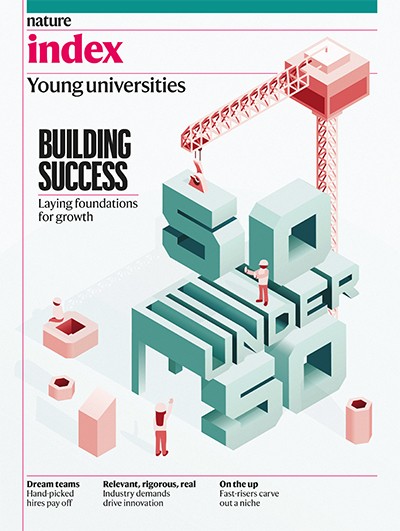The Nature Index is a database of author affiliations and institutional relationships. The index tracks contributions to research articles published in 82 high-quality natural-science journals, chosen by an independent group of researchers.
The Nature Index provides absolute and fractional counts of article publication at the institutional and national level and, as such, is an indicator of global high-quality research output and collaboration. Data in the Nature Index are updated regularly, with the most recent 12 months made available under a Creative Commons licence at natureindex.com. The database is compiled by Nature Portfolio.
Nature Index metrics
The Nature Index uses Count and Share to track research output. A country/territory or an institution is given a Count of 1 for each article that has at least one author from that country/territory or institution. This is the case regardless of the number of authors an article has, and it means that the same article can contribute to the Count of multiple countries/territories or institutions.
To glean a country’s, territory’s, region’s or an institution’s contribution to an article, and to ensure that they are not counted more than once, the Nature Index uses Share, a fractional count that takes into account the share of authorship on each article. The total Share available per article is 1, which is shared among all authors under the assumption that each contributed equally. For instance, an article with 10 authors means that each author receives a Share of 0.1. For authors who are affiliated with more than one institution, the author’s Share is split equally between each institution. The total Share for an institution is calculated by summing the Share for individual affiliated authors. The process is similar for countries/territories, although complicated by the fact that some institutions have overseas labs that will be counted towards host country/territory totals.
Adjusted Share accounts for the small annual variation in the total number of articles in the Nature Index journals. It is arrived at by calculating the percentage difference in the total number of articles in the Index in a given year relative to the number of articles in a base year and adjusting Share values to the base year levels.
The bilateral collaboration score (CS) between two institutions A+B is the sum of each of their Shares on the papers to which both have contributed. A bilateral collaboration can be between any two institutions or countries/territories co-authoring at least one article in the journals tracked by the Nature Index.
NATUREINDEX.COM
natureindex.com users can search for specific institutions or countries and generate their own reports, ordered by Count or Share.
Each query will return a profile page that lists the country or institution’s recent outputs, from which it is possible to drill down for more information. Articles can be displayed by journal, and then by article. Research outputs are organized by subject area. The pages list the institution or country’s/territory’s top collaborators, as well as its relationship with other organizations. Users can track an institution’s performance over time, create their own indexes and export table data
This supplement
The Nature Index 2021 Young universities supplement is based on the Nature Index database, covering the research articles published between 2015 and 2020. Adjusted Share is calculated by adjusting Share values to 2020 levels.
Nature Index 2021 Young universities
Only universities, including graduate universities, from among the leading 750 academic institutions in the Nature Index for 2020 were considered. They were categorized as young (50 or under) if they were founded as an independent university in 1971 or later and were not formed by the merger or remerger and/or renaming of a university or universities older than 50. The following specific rules were used to judge whether a university is classified as young:
1) It must have been established, founded or opened in 1971 or later.
2) If it was previously a school, college, polytechnic or institute, it qualifies provided it achieved university status in 1971 or later.
3) If it was a branch of a university and then became an independent university, it qualifies provided it became independent in 1971 or later.
4) If the university was formed by the merger of several institutions including a university or universities, the preceding university or universities must be no more than 50 years old.
5) Graduate universities are included.
Although every effort has been made to consistently select young universities by age following the above rules, the question of whether some institutions became genuine ‘new universities’ in the past 50 years, and when, is open to interpretation owing to their very complex histories.
The tables in this supplement show the leading young universities overall and in different subjects, ranked by their article Share in 2020, as well as the top rising young universities based on change in adjusted Share 2019–20.

 Universities under 50 chart a clear roadmap for the future
Universities under 50 chart a clear roadmap for the future
 Young universities forge new paths to success
Young universities forge new paths to success
 Research outliers among universities under 50
Research outliers among universities under 50
 Customized recruitment attracts top talent
Customized recruitment attracts top talent
 Industry demand drives innovation
Industry demand drives innovation
 Universities under 50 carve their niche
Universities under 50 carve their niche


